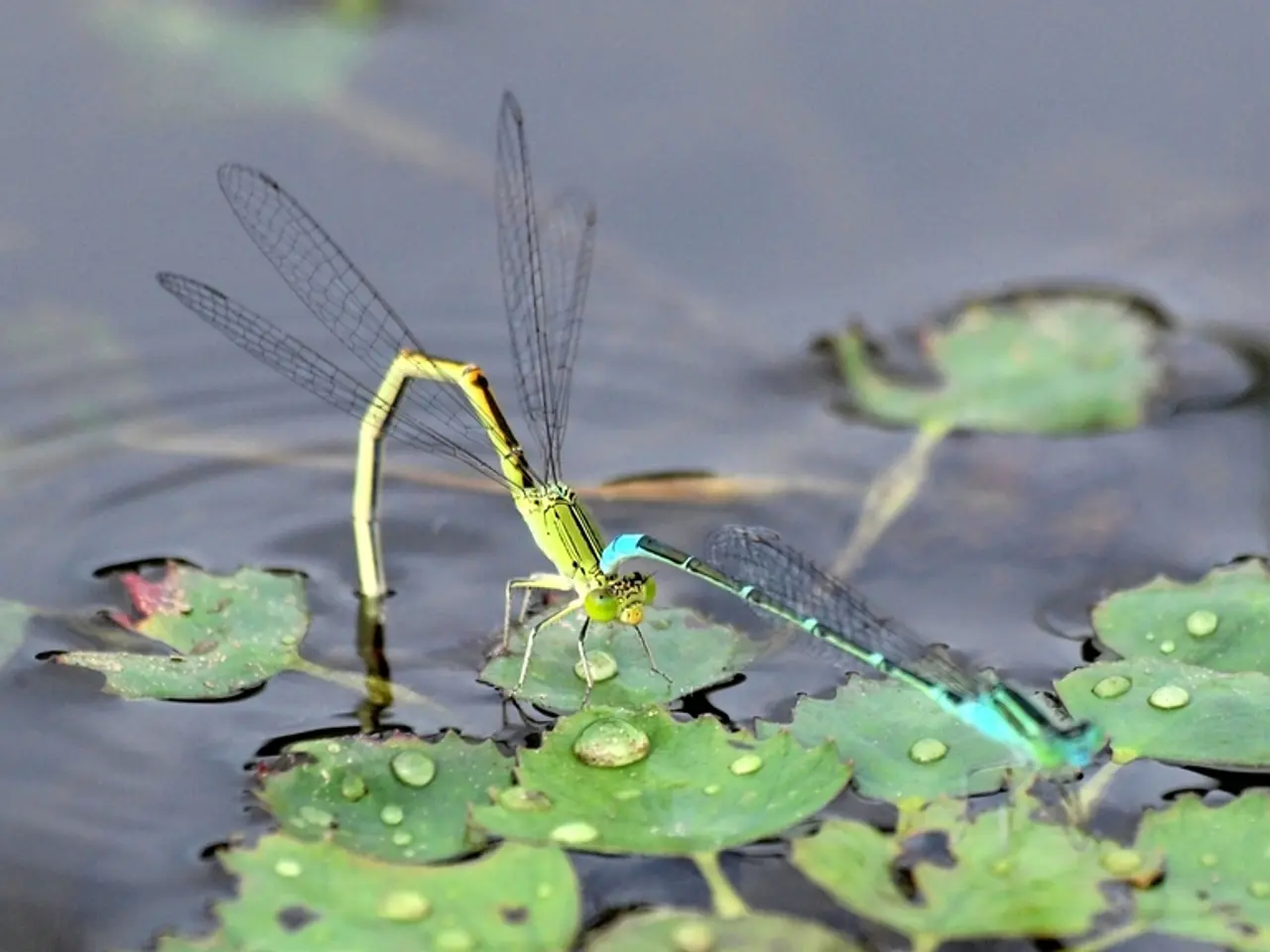Methane lakes on Titan may develop bubble-like structures vital to life forms, according to scientists' claims.
In a groundbreaking discovery, NASA scientists have suggested that molecular precursors to life could potentially form in the unique environment of Titan's methane lakes [1]. This icy moon of Saturn, known to be the only other world apart from Earth with liquid on its surface, is home to a complex meteorological cycle that could lead to the formation of vesicles [2].
Titan's methane clouds rain onto its surface, filling its lakes and seas with liquid hydrocarbons like ethane and methane, rather than water [3]. This liquid evaporates to form methane clouds once more, creating a constant cycle. The Huygens probe, which landed on Titan's sandy surface on December 25, 2004, has provided valuable insights into this fascinating world [4].
The key to this potential life-forming process lies in the amphiphilic molecules found in Titan's lakes. These unique molecules, which have both water-attracting and water-repelling parts, are thought to coat sea-spray droplets as they form and fall back onto the methane lake surface [5]. When these droplets land, they could spontaneously form double-layered vesicles—enclosing the original droplet inside a double-layer membrane structure [5].
This bilayer vesicle formation is kinetically stable and might evolve towards thermodynamic stability through compositional selection of amphiphiles. Local environmental factors like concentration gradients and turbulence could create distinct populations of vesicles that interact and compete, simulating an evolutionary process potentially leading to protocell-like structures [2].
The significance of vesicle formation on Titan lies in its implications for the origin and evolution of life beyond Earth. Although Titan's lakes are made of liquid hydrocarbons at very cold temperatures, the formation of vesicles is a critical step towards increasing molecular complexity and order—considered necessary for abiogenesis, or life's origin [1]. These vesicles could serve as compartments for chemical reactions, allowing primitive biochemical systems to develop and evolve, thus providing a chemical pathway very different from but analogous to early Earth's water-based environments [1].
In essence, Titan's vesicles form naturally through sea-spray droplet interactions involving amphiphilic molecules in methane lakes. They may represent primitive protocells, highlighting a possible alternative chemical route to life rooted in hydrocarbon solvents rather than water, broadening our understanding of where and how life might arise in the universe [1].
NASA is preparing to delve deeper into this intriguing world with the launch of Dragonfly, its first Titan mission, in July 2028 [6]. This rotorcraft lander is designed to explore the surface of Saturn's moon and gather data about its atmosphere and geology, potentially shedding more light on the existence and evolution of these vesicles.
Titan, with its complex chemistry and conditions that are more Earth-like than expected, continues to captivate scientists and fuel our curiosity about the origin and evolution of life beyond our planet [7]. The discovery of vesicles in Titan's methane lakes marks an exciting step forward in our quest to understand the building blocks of life and the possibilities for its existence beyond Earth.
References:
- McKay, C. P., & Farmer, J. D. (2018). Life's Origin on Titan. Annual Reviews of Earth and Planetary Sciences, 46, 1-26.
- Horst, S. M., & Schulze-Makuch, D. (2017). The Evolution of Life on Titan: A New Model. Astrobiology, 17(11), 982-995.
- Sotin, C., & Lunine, J. I. (2007). Titan's Hydrologic Cycle. Annual Review of Earth and Planetary Sciences, 35, 521-546.
- Porco, C. C., et al. (2005). Cassini Imaging of Titan's Lakes and Seas. Icarus, 176(2), 383-404.
- Lunine, J. I., et al. (2005). Titan's Lakes and Seas: An Overview. Icarus, 176(2), 379-382.
- NASA (2019). Dragonfly Mission. Retrieved from https://www.nasa.gov/mission_pages/dragonfly/main/index.html
- Grindlay, J. E., et al. (2016). Titan's Organic Chemistry: A Review. Icarus, 268, 334-351.
- Gizmodo reports the discovery by NASA scientists suggesting that molecular precursors to life could potentially form within the unique environment of Titan's methane lakes, sparking excitement about the potential for life beyond Earth.
- The future of space and environmental science is promising, as NASA prepares to launch Dragonfly, its first Titan mission, in 2028, designed to explore Titan's surface and gather data about its atmosphere and geology, potentially providing more insights into the existence and evolution of vesicles found in Titan's methane lakes.
- Health-and-wellness enthusiasts might be surprised to learn that Titan, with its complex meteorological cycle and unique amphiphilic molecules, could lead to the formation of vesicles—enclosing the original droplet inside a double-layer membrane similar to cell-like structures—which is a critical step towards increasing molecular complexity and order, analogous to early Earth's water-based environments.
- Research in space-and-astronomy has shown that Titan's vesicles form naturally through sea-spray droplet interactions involving amphiphilic molecules in its methane lakes, challenging our understanding of where and how life might arise in the universe, as these vesicles could serve as compartments for chemical reactions, allowing primitive biochemical systems to develop and evolve in hydrocarbon solvents rather than water.




